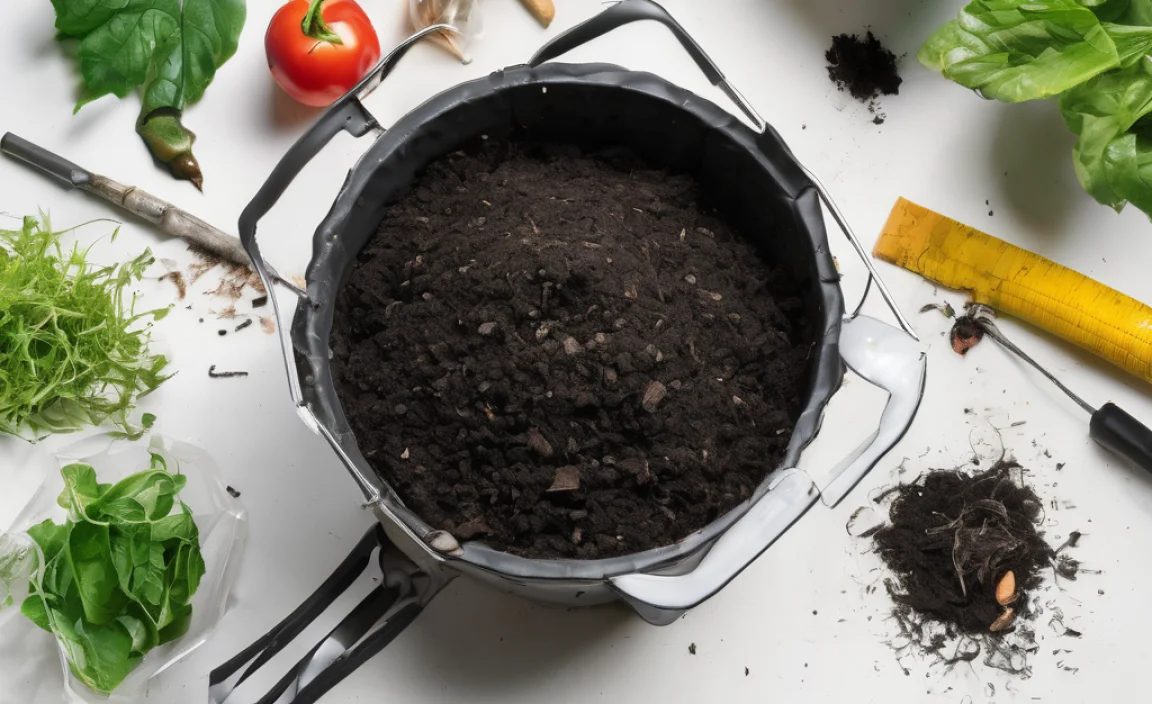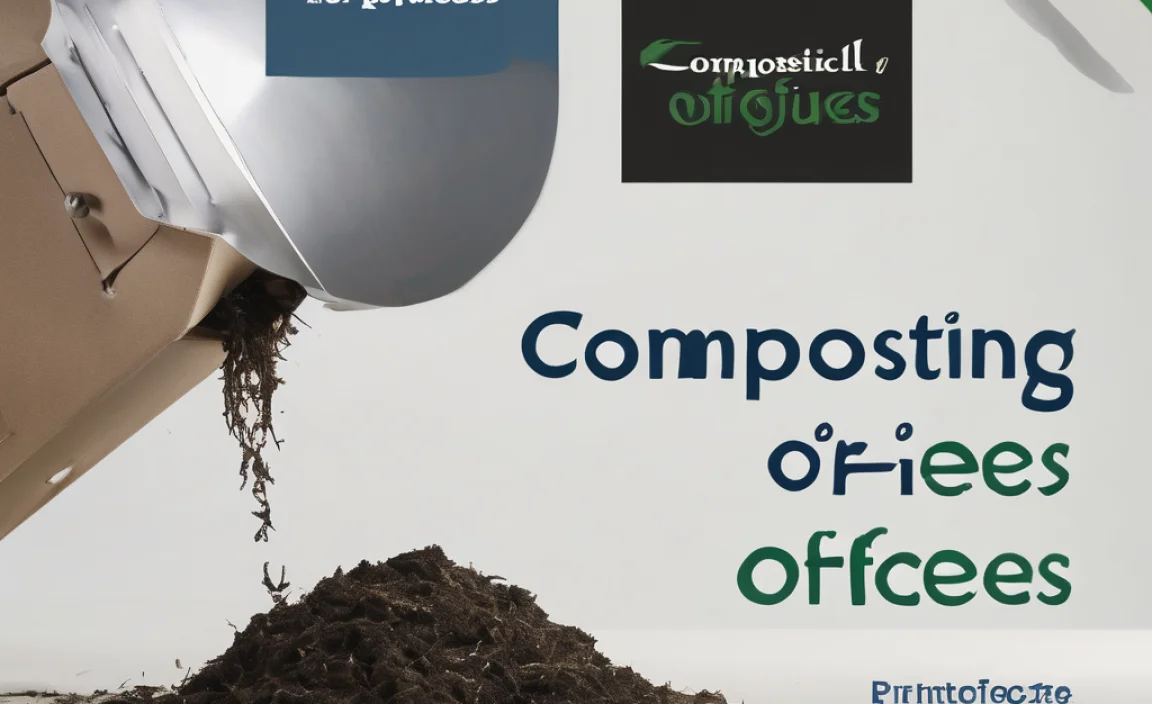Do you know that food scraps can turn into rich soil? It’s called composting! Composting is like a magic trick where waste becomes treasure. Many people are looking for aerobic composting ideas. But what does aerobic mean? It refers to using air to help break down waste. Let’s dive into fun and easy ways to start composting!
Key Takeaways
- Aerobic composting needs air to break down waste.
- Use kitchen scraps for great compost results.
- Turn your compost pile to add oxygen.
- Try different aerobic composting ideas for better results.
- Composting reduces waste and helps the earth.
Aerobic Composting Basics
What is aerobic composting, and why does it matter? Aerobic composting uses oxygen-loving bacteria. These tiny helpers break down waste into rich soil. The process needs air, water, and the right mix of materials. Start with a compost bin or pile. Add layers of green and brown waste. Green waste includes fruit peels and veggie scraps. Brown waste is dry leaves and twigs. Water helps, but don’t make it too wet. Turn the pile often to add oxygen. This speeds up the process and makes it smell nice.
- Use a bin or open-air pile.
- Add kitchen scraps like fruit and veggie peels.
- Include dry leaves for balance.
- Keep the pile moist but not soaking.
- Turn the pile to add air.
- Avoid meat and dairy products.
Composting is a fun way to recycle waste at home. It helps the earth and keeps your garden healthy. Plus, it reduces trash in landfills. You can start small and learn as you go. Soon, you’ll have rich soil for planting. Composting is good for the planet and rewarding for you.
Fun Fact or Stats : Compost can reduce household waste by up to 30%!
What Makes Composting Aerobic?
Ever wondered what makes composting aerobic? It’s all about oxygen! Imagine tiny bacteria that love fresh air. They eat the waste and turn it into compost. Without air, this wouldn’t work. Turning the pile helps mix things up. The air flows through, making bacteria happy. They work faster, and your compost forms quicker. It’s like baking a cake – you need the right ingredients and conditions. Want to help the process? Chop waste into smaller pieces. That way, bacteria can eat faster. Composting is a natural way to recycle.
Why Aerobic Composting Works Better
Why choose aerobic composting? It’s faster and cleaner. Aerobic composting uses air to help break down waste. Think of it as a super team of helpful bacteria. They turn waste into rich soil quickly. No stinky smells because it stays fresh. It’s like having a garden helper doing all the work. Aerobic composting is great for homes and communities. The process is easy to maintain too. Just remember to turn the pile often and keep it moist. Soon, you’ll see the magic of composting in action!
Tips for Faster Aerobic Composting
Want your compost to work faster? Here are some tips! First, cut waste into small pieces. This speeds up the process. Next, turn the pile often. Air is vital for bacteria to work. Water is essential too. Keep the pile moist, but not wet. Balance green and brown waste. Too much of one can slow things down. Add more greens if it’s dry. More browns if it’s too wet. Finally, be patient. Composting is a natural process that takes time. But with these tips, you’ll have rich soil sooner!
Simple Aerobic Composting Ideas
Ready for some easy aerobic composting ideas? You don’t need much to start. A small bin or pile works great. Use kitchen scraps like fruit peels and coffee grounds. Add dry leaves and twigs from the garden. Mix them well and keep the pile moist. Don’t forget to turn it often. This adds air, which is crucial for breakdown. Want to make it fun? Decorate your compost bin. Write friendly reminders like “feed me” on it. This makes the task enjoyable. Plus, it’s a great way to get family involved.
- Start with a small bin or pile.
- Use kitchen scraps like fruit peels.
- Add dry leaves and twigs.
- Turn the pile for air.
- Keep it moist but not wet.
- Decorate your bin for fun.
- Involve family in composting tasks.
Exploring aerobic composting ideas can be exciting. It’s a creative way to recycle waste. You can try different materials and methods. Make it a fun family project. With a little care, you’ll enjoy the benefits of rich soil. Use it for gardening or just to help the environment. Composting is a win-win for everyone!
Fun Fact or Stats : A compost pile can reach 140°F, hot enough to melt snow!
How to Start Composting at Home
Thinking about starting composting at home? It’s simple! First, choose a spot. An old bin or a corner of your yard works well. Next, start collecting scraps. Use fruit peels, veggie bits, and coffee grounds. Add dry leaves and twigs as you go. Water is important too. Keep the pile damp like a sponge. Turn it regularly to add air. This helps break down waste faster. Be patient. It takes a few weeks to months. Soon, you’ll have rich soil for your garden.
Creative Compost Bin Designs
Want a cool compost bin? Get creative! You don’t need a plain bin. Use old barrels or wood pallets for a rustic look. Paint the bin bright colors for fun. Add labels like “fruit,” “veggies,” and “leaves.” This helps sort waste easily. You can even decorate with drawings or stickers. Make it a family art project. Let everyone add their ideas. A creative bin adds excitement to composting. It becomes more than a chore. It’s a fun way to recycle. Plus, a decorated bin looks great in the yard!
Making the Most of Kitchen Scraps
Want to make the most of kitchen scraps? Use them for composting! Fruit peels, veggie bits, and even coffee grounds work well. Avoid meat and dairy as they attract pests. Mixing different scraps helps balance the pile. Add dry leaves for extra nutrients. Keep the pile damp but not wet. Turn it often for air. This helps break down scraps faster. Soon, you’ll have rich soil for your plants. Composting kitchen scraps is easy and fun. It reduces waste and helps the earth. Everyone can join in and learn!
Advanced Aerobic Composting Techniques
Want to level up your composting skills? Try advanced aerobic composting techniques. One method is using a compost tumbler. These are bins that you can spin. They mix the compost and add air. This speeds up the process. Another technique is adding worms to the pile. Worms help break down waste faster. They love moist conditions and bring air into the compost. Both methods require little effort. They’re perfect for busy families. Remember to keep trying new things. Find what works best for you and your space.
| Technique | Effort Level | Speed | Notes |
|---|---|---|---|
| Compost Pile | Low | Medium | Requires turning |
| Compost Tumbler | Medium | High | Easy to rotate |
| Worm Composting | Low | High | Great for small spaces |
| Bokashi Composting | Medium | High | Ferments food waste |
- Use a compost tumbler for easy turning.
- Add worms for faster breakdown.
- Experiment with different techniques.
- Find what works best for you.
- Try to compost all year round.
- Keep the pile moist and aerated.
- Share techniques with friends and family.
Advanced techniques make composting more efficient. It’s fun to try new methods. You can see results faster. Plus, it’s a great way to involve everyone. As you learn, share tips with friends. Help them start composting too. Together, you can make a difference for the planet. Remember, every little bit helps!
Fun Fact or Stats : Earthworms can eat their weight in food each day!
Using a Compost Tumbler
Want to try a compost tumbler? It’s an easy way to compost. A tumbler is a container you can spin. It mixes the compost and adds air. This makes the process faster. Tumblers are great for small spaces. They’re easy to use and keep tidy. To start, add your waste. Include fruit peels and dry leaves. Spin the tumbler every few days. This helps air reach all parts. In a few weeks, you’ll have rich compost. It’s a fun and simple way to start. Give it a try!
Adding Worms to Your Compost
Have you heard of adding worms to compost? It’s called vermicomposting. Worms love eating waste. They turn it into rich soil quickly. Start with a small bin. Add moist bedding like shredded paper. Include kitchen scraps like fruit peels. Worms need a damp home. Keep the bin out of direct sunlight. Watch them work their magic. They help break down waste faster. Vermicomposting is great for apartments. It doesn’t need much space. Plus, worms are fascinating to watch. They’re natural recyclers!
Exploring Bokashi Composting
What is Bokashi composting? It’s a special way to ferment waste. Bokashi uses helpful microbes. They break down food quickly. You start with a Bokashi bucket. Add kitchen scraps and sprinkle Bokashi mix. Press the waste down to remove air. Close the lid tightly. In a few weeks, the waste ferments. Use it in the garden, or add it to compost. Bokashi is fast and easy. It works well in small spaces. Plus, it handles all food types. Curious to try? Bokashi is a fun composting method!
Conclusion
Aerobic composting is a fun way to recycle. Try different aerobic composting ideas for great results. You can help the environment and enjoy rich, healthy soil. Get creative with bins and involve your family. Remember, composting reduces waste and enriches your garden. Happy composting!
FAQs
Question: What is aerobic composting?
Answer: Aerobic composting is breaking down waste with air. It uses oxygen-loving bacteria. They turn waste into rich soil. It’s faster and cleaner than other methods. Aerobic composting needs air, water, and the right mix of materials. Try different aerobic composting ideas for the best results.
Question: Why should I try aerobic composting?
Answer: Aerobic composting is good for the environment. It reduces waste and creates rich soil. It’s faster and cleaner than other composting methods. With simple aerobic composting ideas, you can easily start at home. Turn your kitchen scraps into treasure!
Question: What can I use in aerobic composting?
Answer: Use kitchen scraps like fruit peels and veggie bits. Add dry leaves and twigs. Avoid meat and dairy, as they attract pests. Balance green and brown waste for best results. Experiment with different aerobic composting ideas to see what works. Enjoy turning waste into rich soil!
Question: How do I maintain aerobic composting?
Answer: Keep the pile moist, like a damp sponge. Turn it often to add air. Use a mix of green and brown waste. Avoid overwatering or letting it dry out. Try using a compost tumbler for easy turning. Aerobic composting ideas can help you maintain a successful compost pile.
Question: What are the benefits of composting?
Answer: Composting reduces waste and creates nutrient-rich soil. It helps the environment by lowering landfill trash. Composting is easy to start and maintain. With aerobic composting ideas, you can make it faster and cleaner. It’s a rewarding way to recycle kitchen and garden waste.
Question: Can I compost in small spaces?
Answer: Yes, you can compost in small spaces! Use a compost tumbler or a small bin. Try vermicomposting with worms for fast results. Bokashi composting is another option for limited space. Use creative aerobic composting ideas to make the most of your area. Everyone can compost, no matter the size of their home!



